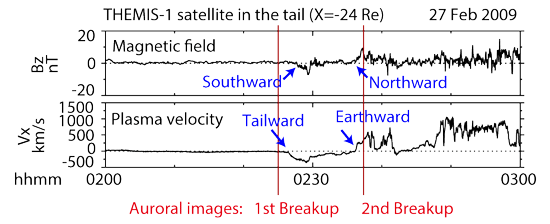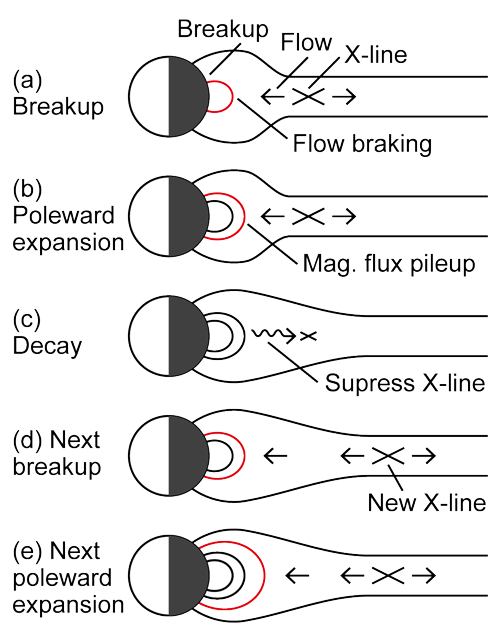
2016 THEMIS SCIENCE NUGGETS
Stepwise tailward retreat of magnetic reconnection: THEMIS observations of an auroral substorm
by Aki Ieda
ISEE, Nagoya University, Japan
Introduction
Auroral breakups are explosive brightening of auroras (northern lights) in the polar region. Their dynamic motion and diversity can be partly understood using combinations of ground and satellite observations. The present study focuses on the tendency that auroral breakups are often repeated in approximately 10-min intervals, and new breakups are sometimes initiated in higher latitudes.
| Figure 1. (a) Ground observatories plotted over a map of Canada and Greenland on 27 February 2009. (b) The first auroral breakup seen in white-light images plotted over a map. (c) The second auroral breakup was initiated at a latitude higher than the first breakup. |
Results
Figure 1a shows ground observatories in Canada and Greenland near midnight. We used auroral cameras at NRSQ and SNKQ stations. Observed auroral images plotted over geographical maps (Figures 1b and 1c) show the first and second auroral breakups. The third breakup is not shown. These breakups were repeated at approximately 10-min intervals. The second breakup was initiated at a latitude higher than the first breakup.
| Figure 2. Interpretation of tailward-then-earthward plasma flows in the magnetic tail. |
Auroral breakups are supposed to be powered by the disconnection (magnetic reconnection) of Earth’s magnetic tail (Figure 2). The magnetic reconnection is evidenced by the fast plasma flows observed by THEMIS-1 satellite (Figure 3). Plasmas were flowing tailward (negative velocity) for the first breakup, and earthward (positive velocity) for the second breakup, indicating that the magnetic reconnection site (X-line) moved tailward (Figure 2).
| Figure 3. THEMIS-1 satellite observations of tailward-then-earthward flows at 24 earth radii down the magnetic tail. |
| Figure 4. Interpretation of the second breakup at a higher latitude than the first breakup. |
Conclusion
The second breakup was initiated at a higher latitude (Figure 1c) than the first breakup. Simultaneously, the reconnection site moved tailward (Figures 2 and 3). Our interpretations of these observations are summarized in Figure 4 as follows. Reconnection-associated flow cases: (a) the first breakup, (b) magnetic flux pileup. (c) Piled-up magnetic field lines push and suppress the magnetic reconnection site. (d) A new reconnection site is created further down the tail. This new reconnection causes a new auroral breakup at a higher latitude, which corresponds to the surface of the piled-up magnetic field lines.
Reference
Ieda, A., et al. (2016), Stepwise tailward retreat of magnetic reconnection: THEMIS observations of an auroral substorm, J. Geophys. Res. Space Physics, 121, 4548–4568, doi:10.1002/2015JA022244.Biographical Note
Aki Ieda is an assistant professor in space physics at Institute for Space-Earth Environmental Research (ISEE), Nagoya University, Japan. He works on auroral breakups (substorms) using satellite observations of the magnetotail with satellite and ground observations of auroras.
 Please send comments/suggestions to
Emmanuel Masongsong / emasongsong @ igpp.ucla.edu
Please send comments/suggestions to
Emmanuel Masongsong / emasongsong @ igpp.ucla.edu




